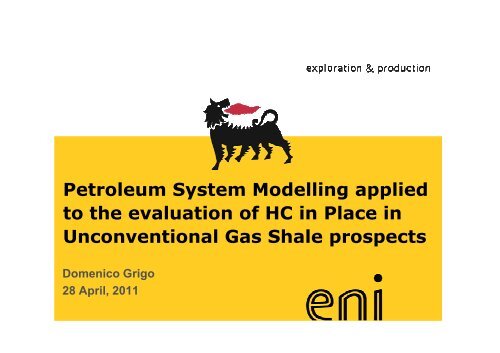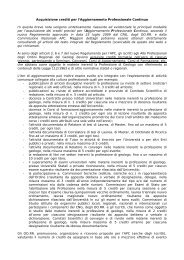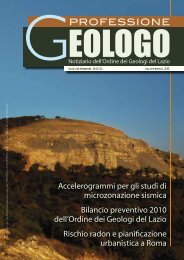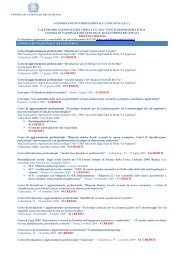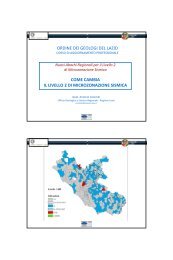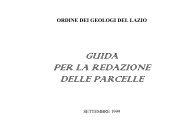kerogen
kerogen
kerogen
You also want an ePaper? Increase the reach of your titles
YUMPU automatically turns print PDFs into web optimized ePapers that Google loves.
Petroleum System Modelling applied<br />
to the evaluation of HC in Place in<br />
Unconventional Gas Shale prospects<br />
Domenico Grigo<br />
28 April, 2011<br />
www.eni.it
PSM applied to Gas Shale Prospect characterisation<br />
Why<br />
PSM<br />
In the first phase of a non american gas shale prospect<br />
evaluation the well data resolution is so large that the normal<br />
approach (quantification of well data only) is not enough to<br />
describe properly the properties distribution.<br />
American Gas Shale (Barnett)<br />
Prospect well data<br />
The estrapolation of well data to the entire prospect extension<br />
can be succesfully supported by the numerical simulation of<br />
the natural processes gouverning the properties distribution.<br />
Petroleum System Modelling is the only methodology capable<br />
to reproduce natural processes starting from well data at basin<br />
scale<br />
Non American Gas Shale<br />
Prospect well data<br />
250 km<br />
1000 km<br />
2
Methods for characterising a Gas Shale<br />
The North American analog<br />
PSM<br />
Key characteristics noted about each system (where available)<br />
Time equivalent system Total porosity (%)<br />
Basin<br />
Age<br />
TOC (%)<br />
Kerogen type<br />
Thermal maturity (%R o )<br />
Gas in place (bcf/section)<br />
Shale gas-in-place resource (tcf)<br />
Absorbed gas (%)<br />
Matrix permeability<br />
Relative thickness<br />
Reservoir pressure (psi)<br />
Bottom-hole temperature (°C)<br />
Depositional setting*<br />
Basin type/ tectonic setting*<br />
Lithology notes<br />
Other notes<br />
* Hypothesized as potential common denominator<br />
3
Methods for characterising a Gas Shale<br />
The North American analog<br />
PSM<br />
4
Gas Shales: unconventional reservoir<br />
PSM<br />
<br />
<br />
<br />
<br />
Gas accumulation is continuous and not related to buoyancy<br />
The formation is simultaneously source rock and reservoir<br />
Gas presence is not associated to geological traps: the target is a<br />
portion of basin<br />
Gas production achieved only with fracture stimulation<br />
Not all the shale gas plays can commercially produce gas<br />
Key geological factors are:<br />
TOC >1% with %Ro>1,2<br />
Quality of organic matter: type II <strong>kerogen</strong>e is the most favourable<br />
Vshale3500 m can<br />
be acceptable<br />
5
PSM<br />
Gas Shale Maturity<br />
6
Maturity Indicators<br />
20<br />
15<br />
Depth (m): 1892,5<br />
Sample Type: BC<br />
Ro=0.60% - Std Dev. =0.06<br />
PSM<br />
•Vitrinite Reflectance (Ro%)<br />
records only the maximum temperature<br />
reached during burial<br />
N° of Readings<br />
10<br />
5<br />
0<br />
0 0.5 1 1.5 2<br />
Vitrinite Reflectance (Ro%)<br />
•Apatite Fission Track (AFTA)<br />
records also other temperatures but only if<br />
younger than the maximun<br />
•Fluid Inclusions (FI)<br />
records all the temperatures<br />
7
Equivalent Vitrinite Reflectance (Ro %)<br />
Derived by Bitume reflectance<br />
PSM<br />
Vitrinite is often scarse in carbonate source rocks. Bitumen can<br />
be present in this case, in particular when the maturity level is<br />
middle/high.<br />
By the use of Jacob’s formula<br />
(Jacob & Hiltmann, 1985) it is<br />
possible to convert the bitumen<br />
reflectance in equivalent<br />
vitrinite reflectance value:<br />
Ro eq % = 0.618 R BIT + 0.40<br />
5<br />
8
Equivalent Vitrinite Reflectance (Ro %)<br />
Derived by other organisns<br />
PSM<br />
From Suchy et Al. 2004<br />
CAI = Conodont Alteration Index<br />
9
Equivalent Vitrinite Reflectance (Ro %)<br />
Tmax by pyrolysis Rock-Eval<br />
PSM<br />
This maturity parameter is derived by the Rock-Eval analysis<br />
(the analytical technique finalized to source rock evaluation).<br />
Tmax is the temperature at<br />
which the maximum of<br />
residual petroleum potential<br />
(by <strong>kerogen</strong> pyrolysis)<br />
occurs.<br />
It has not be confused with<br />
the maximum temperature<br />
(very lower) reached by<br />
sample during its burial<br />
history.<br />
S1<br />
Immature sample<br />
T max = 420 °C<br />
S2<br />
Mature sample<br />
T max = 450 °C<br />
300 300 400 500 °C<br />
Heating rate = 25°C per minute<br />
Overmature sample<br />
T max not<br />
available<br />
10
Petroleum System Modelling<br />
Well Temperature & MaturityCalibration<br />
PSM<br />
WELL<br />
DATA<br />
20<br />
70<br />
Measured<br />
Computed<br />
0<br />
1000<br />
SURFACE<br />
TEMPERATURE<br />
0<br />
1000<br />
WELL BURIAL<br />
EVALUATION<br />
H000<br />
H100<br />
H200<br />
H300<br />
H400<br />
H500<br />
H600<br />
GS<br />
H800<br />
H900<br />
TEMPERATURE HISTORY<br />
120<br />
170<br />
220<br />
Temperature (°C)<br />
TEMPERATURE<br />
MATCHING<br />
2000<br />
Depth (m)<br />
3000<br />
4000<br />
5000<br />
HEAT<br />
FLOW<br />
Depth (m)<br />
2000<br />
3000<br />
4000<br />
5000<br />
6000<br />
7000<br />
150<br />
H000<br />
H100<br />
H200<br />
H300<br />
H400<br />
H500<br />
H600<br />
GS<br />
H800<br />
H900<br />
100<br />
50<br />
Time (ma)<br />
0<br />
150<br />
H000<br />
H100<br />
H200<br />
H300<br />
H400<br />
H500<br />
H600<br />
GS<br />
H800<br />
H900<br />
100<br />
Time (ma)<br />
50<br />
270<br />
0<br />
0.20<br />
0.70<br />
1.20<br />
1.70<br />
2.20<br />
Maturity (Ro%)<br />
6000<br />
0 50 100 150 200 250<br />
Temperature (°C)<br />
Measured<br />
Computed<br />
0<br />
1000<br />
2000<br />
Depth (m)<br />
3000<br />
4000<br />
150<br />
MATURITY HISTORY<br />
100<br />
50<br />
Time (ma)<br />
2.70<br />
3.20<br />
0<br />
MATURITY<br />
MATCHING<br />
0 1 2 3 4<br />
Ro%<br />
5000<br />
6000<br />
11
Maturity Computation & Potential Gas Shale definition<br />
PSM<br />
1000 km<br />
Gas Shale Maturity<br />
12
PSM<br />
Gas Shale Properties<br />
13
Kerogen<br />
ENVIRONMENT<br />
Aquatic<br />
KEROGEN<br />
TYPE<br />
I<br />
KEROGEN FORM<br />
[ MACERAL]<br />
alginite<br />
ORIGIN<br />
algal bodies<br />
structureless debris of<br />
algal bodies<br />
HC<br />
POTENTIAL<br />
PSM<br />
The potential to generate hydrocarbons and the quality of the products are affected by<br />
the quality of the initial <strong>kerogen</strong>, which is controlled by the quality of the organic input<br />
and by the evolution of diagenesis.<br />
On the basis of optical examination and physicochemical analyses, <strong>kerogen</strong>s have been<br />
gathered into four main groups:<br />
Terrestrial<br />
II<br />
III<br />
IV<br />
amorphous<br />
organic<br />
matter<br />
exinite<br />
vitrinite<br />
inertinite<br />
(modified, after Merrill, 1991)<br />
structureless, planktonic<br />
material,<br />
primarily of marine origin<br />
skins of spores and pollen,<br />
cuticle of leaves and<br />
herbaceous plants<br />
fibrous and woody plant<br />
fragments and strcturless<br />
collidal humic matter<br />
oxydized, recycled woody<br />
debris<br />
OIL<br />
GAS AND<br />
SOME OIL<br />
NONE<br />
GENETIC<br />
POTENTIAL<br />
+<br />
-<br />
14
Steps of Organic Matter evolution<br />
Diagenesis is strongly<br />
controlled by the biological<br />
activity (bacteria), and by the<br />
chemical environment (redox<br />
conditions, mineralogy).<br />
At the end of diagenesis,<br />
the organic matter consists mainly<br />
of a policondensed structure which<br />
is the <strong>kerogen</strong>.<br />
Catagenesis and<br />
Metagenesis, are controlled<br />
by thermal stress due to burial<br />
Both the absolute<br />
temperatures and the heating<br />
rate govern the evolution of<br />
<strong>kerogen</strong> transformation.<br />
≅<br />
-<br />
10 m<br />
THERMAL<br />
EVOLUTION<br />
+<br />
MACROMOLECULES<br />
INITIAL KEROGEN<br />
KEROGEN<br />
KEROGEN<br />
DEGRADATION<br />
RESIDUAL KEROGEN<br />
(after Bordenave, 1993 modified)<br />
early<br />
diagenesis<br />
diagenesis<br />
catagenesis<br />
metagenesis<br />
PSM<br />
C,H,O,N<br />
N<br />
C,H,O<br />
O<br />
C,H<br />
H<br />
C<br />
15
Source Rock<br />
Evaluation<br />
Source rock Evaluation: Geochemical log<br />
Quantitative analysis<br />
Source potential<br />
Qualitative analysis<br />
PSM<br />
Thermal Maturity<br />
FORMATION<br />
MARNES<br />
DE<br />
MADINGO<br />
450<br />
TOC S2<br />
HI KEROGEN<br />
TMAX<br />
COMPOSITION<br />
P F G VG P F G VG 450<br />
450<br />
III II I IMM M V M<br />
DOLOMIE DE<br />
LOANGO<br />
950<br />
950<br />
950<br />
GRES<br />
DE<br />
TCHALA<br />
CARBONATES DE SENDJI<br />
1450<br />
1950<br />
1450<br />
1950<br />
TRACES<br />
TRACES<br />
1450<br />
1950<br />
SALIFERE DE LOEME<br />
2450<br />
2450<br />
Oil prone<br />
AOM<br />
MPH<br />
CHF<br />
CWF<br />
2450<br />
ARGILES DE<br />
POINT INDIENNE<br />
T.D. 2782<br />
0 1 2 3 4 5 6<br />
(%)<br />
0 1 10 100<br />
(kg HC/ton of rock)<br />
0 200 400 600 800 1000<br />
(mg HC/g TOC)<br />
0 20 40 60 80 100<br />
(%)<br />
Serie1<br />
400 420 440 460 480 500<br />
(°C)<br />
16
Kerogen optical analyses<br />
Some <strong>kerogen</strong> types are shown:<br />
Microscope pictures of <strong>kerogen</strong>s<br />
Observation in transmitted white light<br />
PSM<br />
_________________<br />
More or less 100 µ<br />
1. Humic Kerogen<br />
(woody fragments, and then vitrinite<br />
and others coal macerals)<br />
2. Sapropelic Kerogen<br />
(spores and pollens)<br />
3. Kerogen constituted by<br />
Amorphous Organic Matter<br />
(unstructured, unrecognizable OM)<br />
17
The Seismic view of a Source Rock<br />
PSM<br />
18
Source rock lithological model<br />
PSM<br />
(50-80% shale)<br />
(80-90% shale)<br />
(90-100% shale)<br />
19
Organic matter deposition & preservation modelling<br />
PSM<br />
OF-Mod 3D:<br />
is a process-based software, which reproduce the development<br />
and the variation of organic facies in a 3D volume.<br />
TOM supply<br />
1 fluvial sediment<br />
primary productivity PP (g C·m -2·a-1 )<br />
and nutrient supply<br />
CO 2 + H 2 O CH 2 O + O 2<br />
PP = 250 - 300 g C·m-2·a-1<br />
PP = 50 – 60 g C·m -2·a * -1 *<br />
* *<br />
*<br />
*<br />
PP = 100 - 250 g C·m *<br />
*<br />
-2·a * * * *<br />
* * *<br />
*-1<br />
2 * *<br />
*<br />
*<br />
*<br />
* * * * * *<br />
*<br />
* * * *<br />
2<br />
*<br />
* * *<br />
* *<br />
* *<br />
* * * *<br />
* *<br />
3 * * * * * ***<br />
*<br />
carbon flux<br />
* *<br />
Fc<br />
* * *<br />
*<br />
*<br />
*<br />
*<br />
*<br />
*<br />
*<br />
*<br />
*<br />
*<br />
*<br />
* * * * ** 4 *<br />
*<br />
*<br />
*<br />
4<br />
* * * **<br />
*<br />
Ctot: 10 wt%<br />
Ctot: 7 wt%<br />
degradation<br />
OF: B<br />
OF: C - A<br />
* 6<br />
*<br />
MOC (anoxic)= PP · PF · dilution<br />
epibenthic respiration<br />
5<br />
*<br />
Ctot: 1-3 wt%<br />
BFM erosion, bypass and<br />
OF: BC-C<br />
burial efficiency BE<br />
sedimentation processes<br />
Ctot: 0.3 wt%<br />
OF: D MOC (oxic) = Fc · BE · dilution<br />
water depth (m)<br />
TOM = Terrestrial Organic Matter<br />
SINTEF Petroleum Research<br />
20
Final Outcome:<br />
Gas Shale Thickness & Original properties definition<br />
PSM<br />
Original TOC=15%<br />
Original HI=350<br />
mgHC/gTOC<br />
1000 km<br />
21
Final outcome:<br />
Gas Shale Depth & Burial Evolution<br />
PSM<br />
1000 km<br />
22
PSM<br />
Gas Shale original Gas in place<br />
23
HC genaration simulation<br />
Experimental Kinetic Parameters<br />
The parameters defining the reaction scheme are determined experimentally<br />
degrading thermically the <strong>kerogen</strong> samples with the MSSV (Micro Scale<br />
Sealed Vessel) pyrolysys experiments<br />
OPTIMIZATION OF RESULTS<br />
PSM<br />
ACCORDING TO A KINETIC SCHEME<br />
USE IN THE<br />
SIMULATION OF<br />
HC GENERATION<br />
AND EXPULSION<br />
24
Calibration of the Kinetic Model<br />
Original properties definition<br />
PSM<br />
Av. Source Rock Maturity 1.6 Ro%<br />
TOC (%)<br />
0 1 10 100<br />
4400<br />
HI mgHC/gTOC<br />
1 10 100 1000<br />
4400<br />
4420<br />
4420<br />
4440<br />
4440<br />
Measured<br />
Measured<br />
Computed<br />
4460<br />
Depth (m)<br />
Computed<br />
4460<br />
Depth (m)<br />
4480<br />
4480<br />
MODELLED GAS SHALE<br />
15 % TOC – HI 350<br />
mgHC/gTOC<br />
38 m<br />
4500<br />
4520<br />
4500<br />
4520<br />
25
Expulsion Simulation Why <br />
PSM<br />
GENERATED GAS EXPELLED GAS<br />
Between Generation and Expulsion of HC a time gap can exists but<br />
also a volume gap due to the un-expelled HC remaining in the<br />
source and not available for Migration and Charging<br />
26
Final outcome:<br />
Gas Shale OGIIP Volumes by area<br />
PSM<br />
The same process of<br />
evaluation can be<br />
applied at any scale<br />
from the basin to the<br />
block following the<br />
maturation of the Gas<br />
Shale exploration<br />
project<br />
1000 km<br />
27


